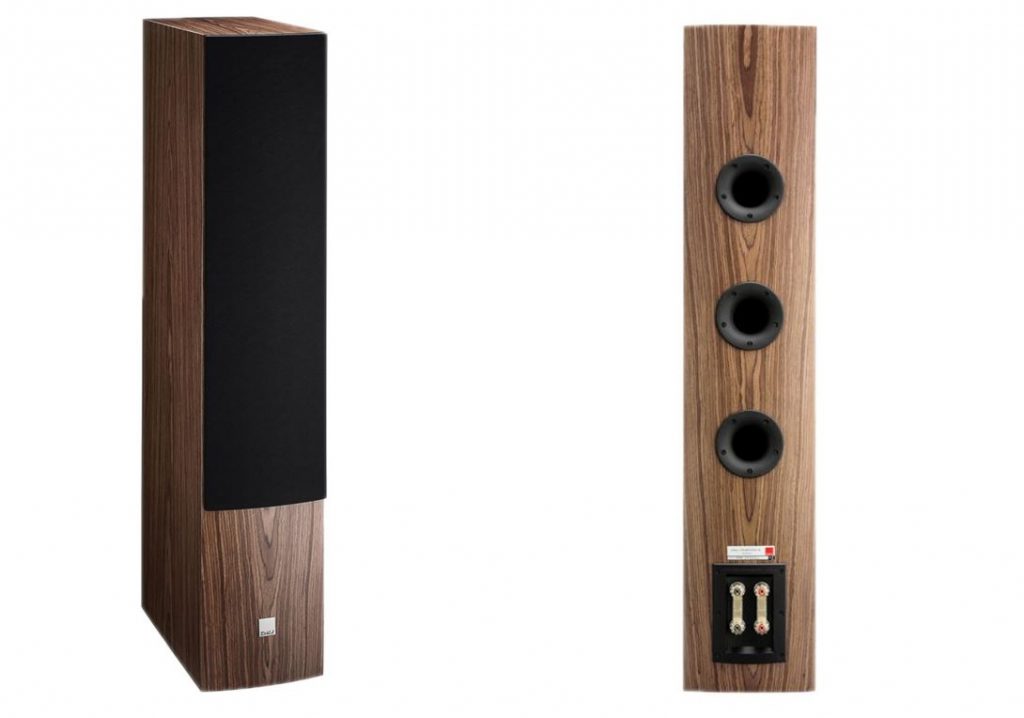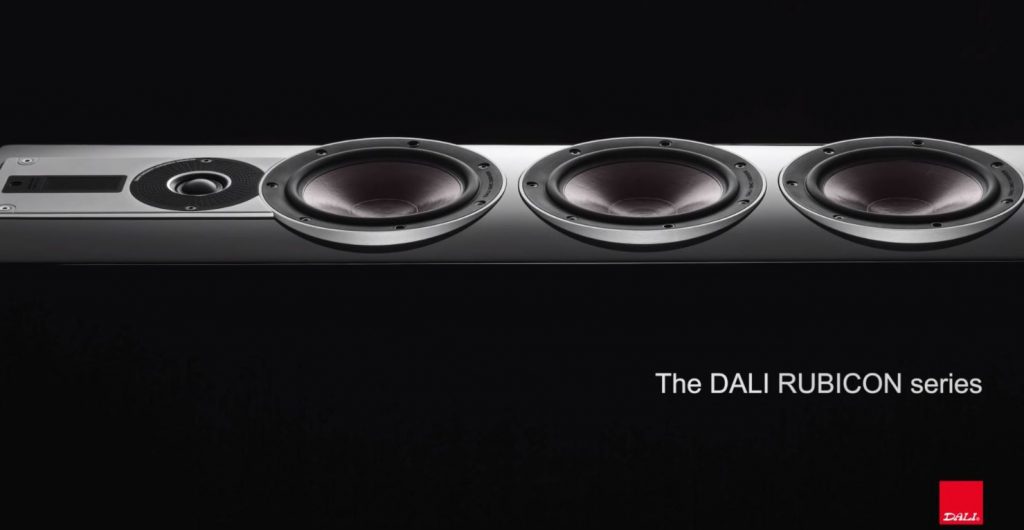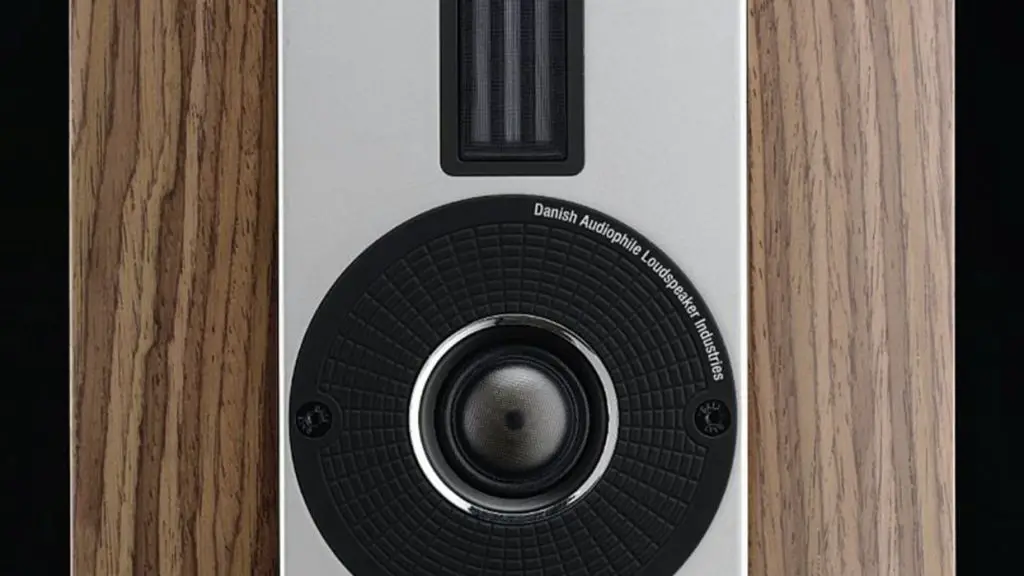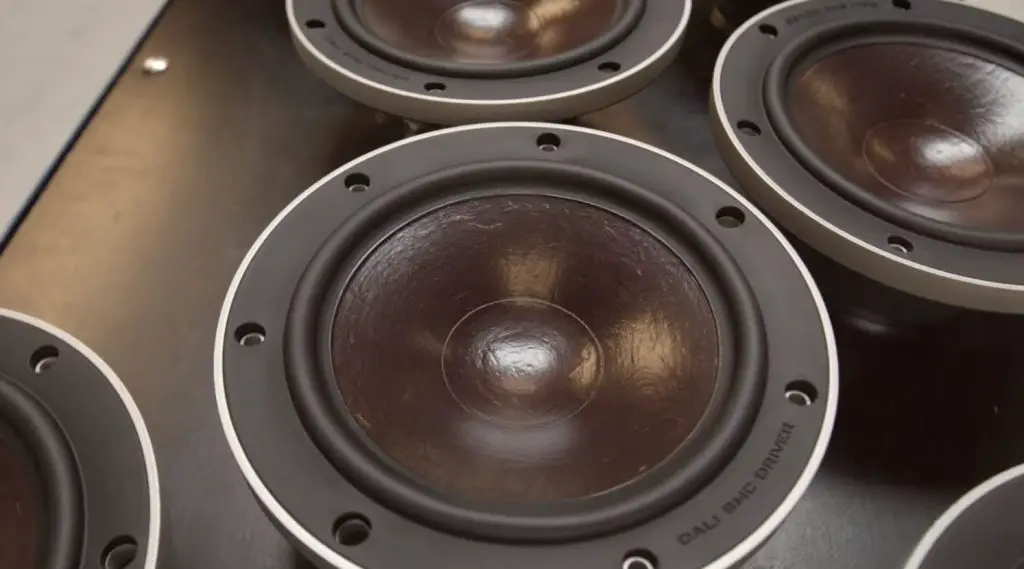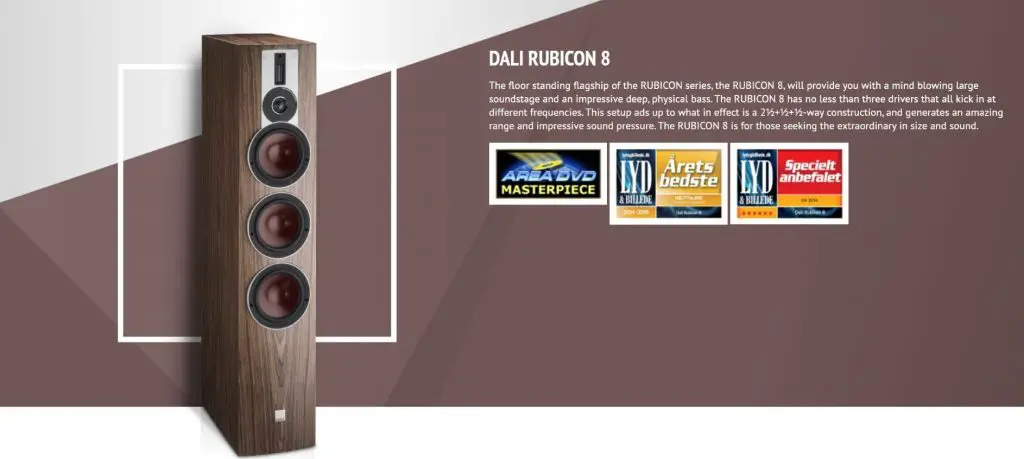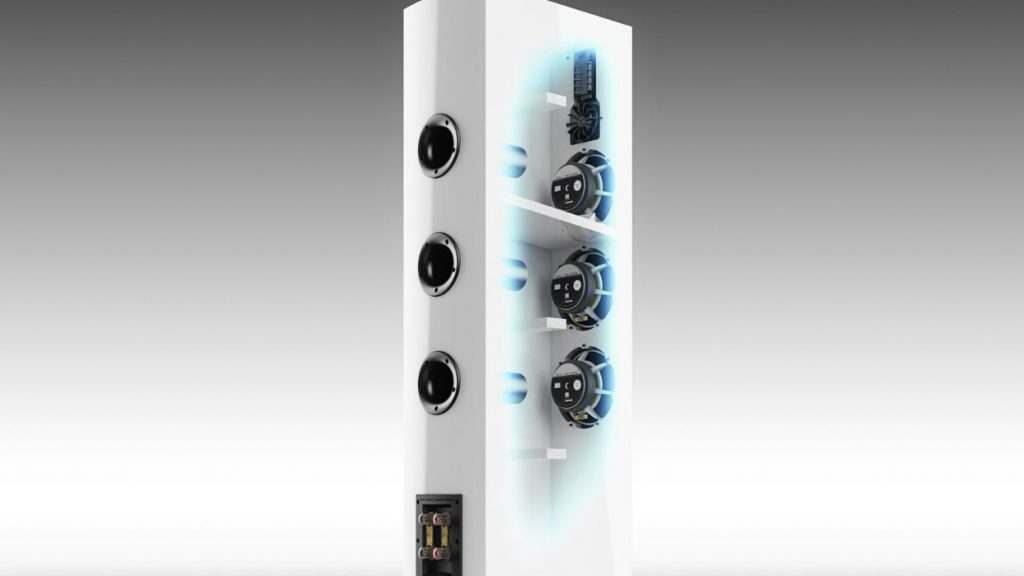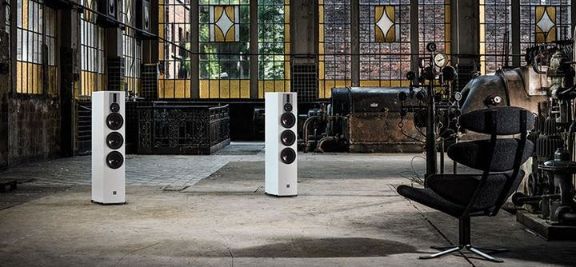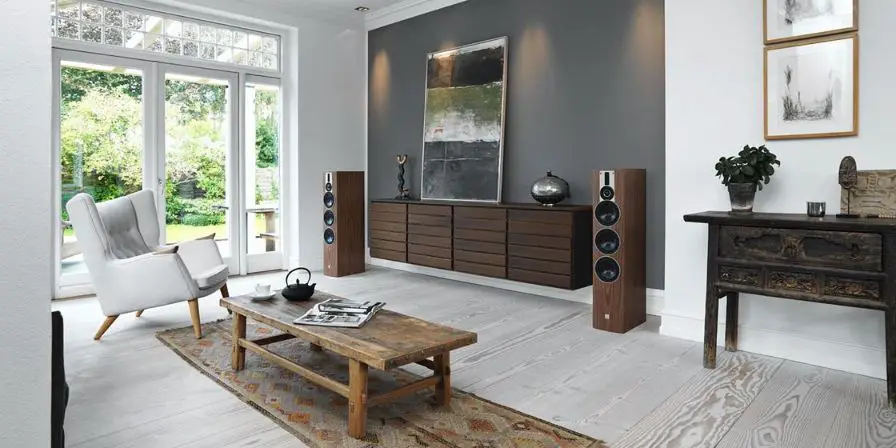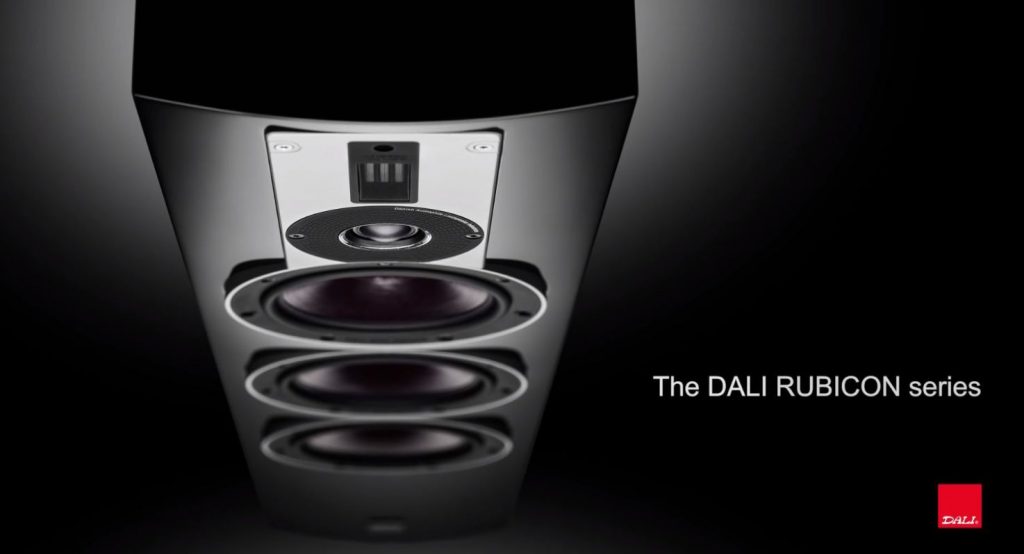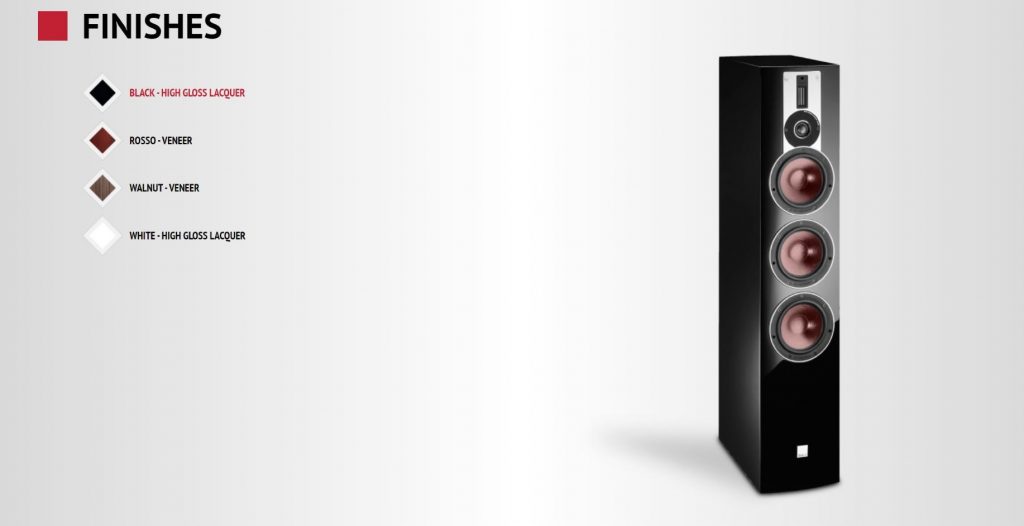Dali Rubicon 8 Review
When most people hear “Dali”, the first thing they think of is nothing more than the Surrealist painter Salvador Dali. Even when searching on Google, they find Dali’s related links before seeing the “DALI -speakers” official website. I also like Dali’s paintings, his imaginative creations, and each one has a creative idea for people to take pictures of. But our Dali speaker manufacture is not in such a wild style, and there is no relationship between the two. And in this post, I will review the Dali Rubicon 8 floorstanding speaker.
With more than 30 years of production experience, Dali has accumulated many know-hows and developed many exclusive technologies. Moreover, their speakers are not gimmicky, and they are not odd-shaped. They claimed that the products must satisfy the needs of enthusiasts.
Six Key Elements in Designing Speakers
The Dali advertised that they had six key elements in designing speakers:
- 3D audio;
- Amplifier optimized;
- Handcrafted;
- Time coherence ;
- Wide dispersion;
- Low resonance cabinet;
Regarding the “3D sound”, Dali said that they have always paid attention to the low loss of sound signal in the production of speakers so as to create a lively sound effect with rich details and full of sound throughout the space. The designer of Dali has to make the speaker disappear in the space instead of allowing the listener to point out the precise location of the speaker quickly. That is the meaning of “3D sound”.
Secondly, Dali also values the speaker impedance change to be small and strives to obtain the most consistent impedance under the complete frequency response, making the amplifier work more efficiently. Dali speakers are hand-made in Denmark, but the factory has set a strict quality control process to ensure that each production process’s handwork and assembly line with Dali’s production standards. The products are also thoroughly tested before leaving the factory.
Dali’s various series of speakers strive to have the same time phase between each unit regardless of the price. This depends on the design of the unit, crossover and cabinet to achieve the most suitable combination. That helps Dali speakers can achieve a more lively and three-dimensional sound field, allowing the speakers to have a disappear feeling in the listening space.
Also, Dali speakers have good diffusion. They hope that the sound from the speakers can be harmoniously blended with the entire space. Therefore, even if the listener leaves the sweet spot, they can still hear a soft and clear sound.
Finally, the resonance of the speaker cabinet is one of the killers that degrade the sound quality. Dali uses the strengthening of the cabinet structure and the mix of different materials to minimize the resonance of the speaker cabinet to avoid the sound pollution caused by the cabinet vibration.
Design of Rubicon 8
The Dali Rubicon series is second to Dali’s highest-end Epicon series, bridging the gap with the Helicon series. This series not only shares the technological achievements of Epicon but also obtains the sound performance closest to the Epicon series at a relatively more affordable price.
Rubicon 8 tower speaker is the big brother of this series. The tweeter adopts a hybrid design, combining a 29mm soft dome tweeter and a 17x45mm aluminium ribbon tweeter. The 29mm soft dome tweeter uses an ultra-light diaphragm, and the voice coil has also abandoned the traditional copper wire voice coil for lightweight and agility. Instead, it uses aluminum-plated copper wire with powerful magnets, which has its own characteristics.
The high-frequency extension can reach 26kHz. But Dali believes that this is not enough, so the low-pass crossover point is set to 14kHz for the soft hemisphere monomer, and the above frequency response range is assigned to the 17x45mm aluminium ribbon tweeter.
The ribbon tweeter has a better high-frequency extension than soft hemispherical tweeters and has a larger horizontal dispersion angle. That allows Rubicon 8 to extend the high-frequency up to 34kHz and improve the horizontal dispersion of the tweeter.
Under the hybrid tweeter module, there are three seemingly identical 6.5-inch wood fibre diaphragm speaker monomers. Each of these three monomers is responsible for the frequency band. The top one is mainly responsible for the midrange, and the lower two are responsible for enhancing the low-frequency range. Dali sets the low-pass crossover point for them, and the midrange unit is responsible for connecting the treble, and the sound below 2.5kHz is his range.
The second unit is responsible for enhancing the bass below 800Hz, and the low-pass crossover point of the bottom one is at 500Hz. Because these three wood fibre diaphragms have only low-pass crossover points, therefore, Dali described Rubicon 8 as 2½ + ½ + ½ construction.
The wood fibre diaphragm used by Dali on Rubicon 8 is not simple. Dali used it on the Epicon series. The moving coil single diaphragm is light and robust. Dali also emphasized that the surface of the diaphragm is not flat, which allows the speaker unit to reduce the energy accumulated in front of the diaphragm to cause resonance when the piston is moving, which helps to reduce the sound stain and increase the details.
With the soft rubber suspension, the energy loss can be minimized. The aluminium alloy frame on the back not only provides good heat dissipation, but the non-magnetic feature also allows the magnetic field formed by the single magnet system to be undisturbed.
SMC Technology
This speaker unit is not just that. Carefully observe the frame of the monomer, there is also a tiny word engraved on it: “Dali SMC Driver”. What is an SMC unit? That is the abbreviation of “Soft Magnetic Compound”.
In short, we can infer that this is a unique formula used to make a single magnet. The important thing is that the original manufacturer emphasized that this SMC magnet has excellent magnetic conductivity and extremely low conductivity.
What are the benefits? Dali tells us that this is to solve a phenomenon that a single magnet is difficult to avoid, called “hysteresis.” “Hysteresis” refers to the phenomenon in which the value of a physical property lags behind changes in the effect causing it, for instance, when magnetic induction lags behind the magnetizing force. That will increase the impedance of the voice coil and cause a certain amount of distortion.
Because the raw material of a single magnet is iron powder, since it is iron, it will conduct magnetism and conduct electricity, so this phenomenon is difficult to avoid. That is why Dali developed the SMC formula. For this material, the magnetic permeability of the magnet will remain, but the conductivity will be 1/10,000 of the general magnet. In this way, the “hysteresis phenomenon” is almost solved, and it also makes the SMC monomer work more linear, and the distortion is lower.
The cabinet of Rubicon 8 is exquisite and beautiful. The wood veneer on the surface is exquisitely handcrafted. The corners are polished neatly. The two sides of the cabinet are parallel straight lines, but the front and rear are curved. Dali speakers have always been straight lines. The Rubicon 8 cabinet uses curved surfaces to ease the masculine appearance and add flavour to the speakers.
Cabinet Design
The Dali Rubicon 8 speaker’s cabinet is made of MDF, and the structure is exceptionally solid. The front panel even uses a 25mm thick plate. When you tap the cabinet with your fingers, you can only hear a deep sound, and no matter whether you hit the centre of any plane of the horn or at the edge, the sound heard is almost the same.
It can be seen that the resonance of the box itself is minimal. If the resonance is slight, the sound stain caused by the cabinet is small. Looking around today’s major Hi-End speaker manufacturers, almost all of them are dedicated to reducing the cabinet resonance.
Dali also revealed that each mid-bass and bass unit of Rubicon 8 has a separate chamber. That can avoid the interference of each unit, but the horizontal partition plate also helps to strengthen the cabinet’s structure.
Bass Port Design
The bass reflex hole on the back or Dali Rubicon 8 is painted finely. If you shine a flashlight into the reflector hole, you can see that the entire airflow tube is painted uniformly. With three 6.5-inch mid-bass and woofers, there are also three bass reflex holes on the back. Here comes the problem: other multi-unit speakers often only have one bass reflex hole, why does Rubicon 8 have three?
Dali believes that the airflow generated by the back waves of the monomers will interfere with each other. In order to prevent these airflow disturbances from affecting the purity of the sound, they separate the back of each driver unit and set up bass reflex holes. In this way, the frequency response of each individual can be corrected more accurately, and the mid-bass sound can be purer.
Dali also stated that based on the principle of “short-distance transmission”. They installed the crossover on the back of the speaker binding posts so that the current from the amplifier would pass directly to enter the crossover and then send it to each unit separately.
When installing the speaker cable, I found that the speaker terminal of Rubicon 8 is straightforward to rotate. The words Dali are etched on the top, which means they are all customized products. Both the Rubicon 8 and Rubicon 5 of the same series are bi-wire floor-standing speakers, while the bookshelf Rubicon 2 and LCR are single-wire.
The jumper attached to Rubicon 8 is not like a typical jumper, which only has a copper piece, but a transparent plastic shell is added to the outside of the jumper. What’s the use of this? It’s very simple, avoiding direct contact with the jumper body with your hands. In this way, the moisture on your hands will not stay on the jumper, and it will not cause oxidation on the jumper’s surface. Dali pays more attention to more than that.
Sound Performance
Dali Rubicon 8 has a very warm and full sound quality. The thickness of the treble is quite good, it sounds a little less airy, but the scene is full. All sounds sound natural. The mid-range and the bass are full so that the sound is very stable. That is the key to the excellent sound of the speaker.
Although Rubicon 8 floorstanding speaker has its own sound characteristics, once the preamp equipment is changed, the changes in the bass are also easy to distinguish. When using Cambridge Audio Azur 851E, the sound is fuller, the midrange is denser, and the treble is full of moisture. When I switch to Audiolab 6000A, the sound is cleaner, and the low frequency is more refined. Two amplifiers with completely different design concepts have very different sound characteristics. Rubicon 8 can let you hear the difference between each other.
In the speaker position, I stretched the left and right channels to about 2.5m and made a slight toe-in. It sounds like the centre image is focused, and the depth is sufficient. The Rubicon 8 sound is known for being thick and full, which sounds a bit strong. So I tried to adjust the inclination angle outwards. I felt that the sound became more open.
Although the focus was not so concentrated, the positioning was still excellent. The depth of the sound field was still full of the layer. There is a degree of openness and closeness. In the end, I decided to follow Dali’s recommendations and put the two speakers directly facing a little bit forward.
Music album “Adiós Nonino”, the performed by the André Rieu, Carlos Buono & The Johann Strauss Orchestra. This record blends jazz, even with the elegance of classical music performance. The whole record sounds not only to retain the instantaneous ups and downs but also to deal with many more subtleties.
Dali Rubicon 8 doesn’t seem cramped at all in the face of complex scenes. Rubicon 8 makes me feel happy. I want first to praise Rubicon 8’s high pitch is really beautiful. When the violin plays, the glorious end rhyme is charming. And when the tone is pulled out, one can see that the Rubicon 8’s treble is solid and thick.
The low-frequency support given by the bass strings can make the music picture full of stability. Rubicon 8’s cello sounded so full that it seemed to be a few inches larger. The piano sound is mellow and strong, especially the sound below the mid-range frequency, which is smooth and full.
If you are a rock or a metal fan and are used to listening to exciting music, try Rubicon 8 to play these kinds of music, and it won’t disappoint you. The thick and full sound gives this music another masculine soul. Take Metallica, a veteran metal group, for example. They have always been known for their swift speed and hit-to-heart remake rhythm. When I listened to the album “Metallica”, that many music lovers are familiar with. The drums are magnificent and powerful.
In the first track, “Enter Sandman“, I was stunned by the sound of drums’ sound. “Sad but True” and “Holier than Thou“, I listened to three songs in a row and enjoyed the thrill of the drum hitting my chest. It’s like you are at the live concert.
The guitar sound must also be mentioned. At the beginning of “Enter Sandman” the guitar melody is repeated repeatedly, starting from the steel-string guitar to the electric guitar, bass, and the bass drum to wake up the orchestra. The whole process gradually accumulates emotional energy. The steel-string guitar sounds really comfortable. If I listen to it on a small speaker system, I sometimes feel that the opening is weak, but Rubicon 8 made me attract from the beginning.
Listening to Metallica’s famous lyric songs, the guitar melodies are also very charming, “The Unforgiven” and “Nothing Else Matters“. The depth of the sound field of the former has been stretched. With the full drum sound, the song is even more dramatic. The guitar sound at the beginning of the latter came from afar. Listening to the crisp sound of the strings, coupled with the subsequent drums, and my whole emotions had been drawn in. The thickness of Rubicon 8’s voice adds a touch of charm to the human voice.
Listen to Brahms Piano Concerto No. 1 played by Alfred Brendel. That is a live recording in Munich in 1985, with Sir Colin Davis conducting the Bavarian Radio Orchestra as a concerto (Decca, 478 2604). Brahms was born in North Germany and faced Western European music style with a more conservative attitude. In the music, on the one hand, you can see his respect and follow for the masters of the classical period.
On the other hand, he has his personal colour biased towards a heavy structure and full of emotions. Rubicon 8 has a very thick sound, rich low frequency and full sound quality, which is particularly suitable for playing Brahms’s works. This recording was quite excellent, and you can hear a satisfying when you listen to it on a small music system, but it is even more magnificent when you listen to it on Rubicon 8.
Conclusion
During the test of Rubicon 8, I really admire the strength of the company DALI. Their sound quality is fine and detailed, and the sound can maintain a soft and rich characteristic. There are not only full and thick mid-frequency range but also low-frequency that is full of energy.
It can be said to be a good pair of speakers who can both listen to music and watch movies. At the same time, the appearance is exquisite and unconventional, and the quality of every little detail is thoughtful. As a mid-level product, it actually uses technology that is unique to the flagship Epicon series.
More importantly, Dali emphasized that Rubicon 8 speaker can be driven with a surround amplifier. That is good news for home theatre audiophiles. I sincerely recommend it to friends who need multi-channel speakers.
Dali Rubicon 8 Specs
- Frequency Range (+/-3 dB) [Hz]: 38 – 34.000
- Sensitivity (2,83 V/1 m) [dB]: 90.5
- Nominal Impedance [ohms]: 4
- Maximum SPL [dB]: 112
- Recommended Amplifier Power [W]: 40 – 250
- Crossover Frequency [Hz]: 500 / 800 / 2.500 / 14.000
- Crossover Principle: 2½ + ½ + ½ way
- Hybrid tweeter module, Super high freq. driver, Quantity: 1 x 17 x 45 mm
- Hybrid tweeter module, Super high freq. driver, Diaphragm type: Ribbon
- Hybrid tweeter module, High frequency driver, Quantity: 1 x 29 mm
- Hybrid tweeter module, High frequency driver Diaphragm type: Soft Textile Dome
- Low frequency driver, Quantity: 3 x 6½”
- Low frequency driver, Diaphragm type: Wood Fibre Cone
- Enclosure type: Bass Reflex
- Bass Reflex Tuning Frequency [Hz]: 33.5
- Connection Input: Bi-Wiring
- Magnetic Shielding: No
- Recommended Placement: Floor
- Recommended Distance From Wall [cm]: 20 – 180
- Dimensions With Base (HxWxD) [mm]: 1,100 x 220 x 445
- Weight [kg]: 27.3
